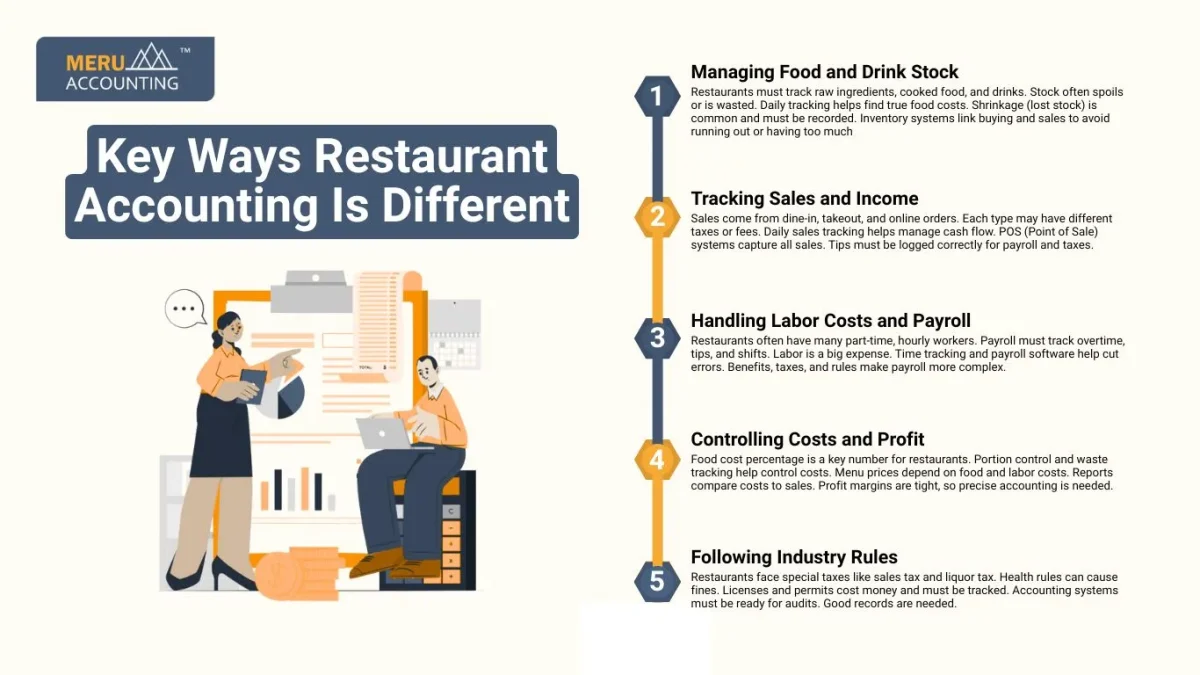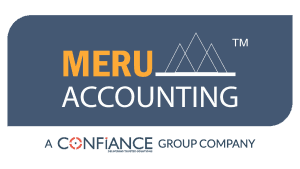Why Accounting for Restaurants Is Different from Other Businesses
Accounting for restaurants is not the same and is more tough than most other jobs. Running a restaurant brings many special tasks that change how cash is tracked. This blog tells why restaurant accounting is one of a kind and shares key facts that owners and managers should know.
Restaurants have lots of sales each day, food that goes bad fast, and many kinds of sales. Labor pay can change each hour, which makes payroll hard. Plus, restaurants must follow special tax and health laws. These things make accounting for restaurants very different from other work.
What Makes Accounting for Restaurants Different?
Restaurants face many unique factors that change accounting for restaurants compared to other businesses:
- Many daily sales: Restaurants handle lots of cash and card payments each day.
- Inventory is tricky: Food and drink stock is hard to track because of spoilage, waste, and portion control.
- Labor costs: Many workers with different hours and pay rates need to be tracked.
- Multiple income sources: Sales come from eating in, takeout, delivery, catering, and more.
- Perishable goods: Food goes bad fast and needs close tracking.
- Rules and laws: Restaurants must follow tax laws, health codes, and licenses.
Because of these points, restaurant accounting is not the same as accounting for stores, service providers, or factories.
Key Ways Restaurant Accounting Is Different
Here are the main ways restaurant accounting stands apart:

- Managing Food and Drink Stock
Restaurants must track raw ingredients, cooked food, and drinks. Stock often spoils or is wasted. Daily tracking helps find true food costs. Shrinkage (lost stock) is common and must be recorded. Inventory systems link buying and sales to avoid running out or having too much. - Tracking Sales and Income
Sales come from dine-in, takeout, and online orders. Each type may have different taxes or fees. Daily sales tracking helps manage cash flow. POS (Point of Sale) systems capture all sales. Tips must be logged correctly for payroll and taxes. - Handling Labor Costs and Payroll
Restaurants often have many part-time, hourly workers. Payroll must track overtime, tips, and shifts. Labor is a big expense. Time tracking and payroll software help cut errors. Benefits, taxes, and rules make payroll more complex. - Controlling Costs and Profit
Food cost percentage is a key number for restaurants. Portion control and waste tracking help control costs. Menu prices depend on food and labor costs. Reports compare costs to sales. Profit margins are tight, so precise accounting is needed. - Following Industry Rules
Restaurants face special taxes like sales tax and liquor tax. Health rules can cause fines. Licenses and permits cost money and must be tracked. Accounting systems must be ready for audits. Good records are needed.
Why is Accurate Accounting Important for Restaurants
- Controls food and labor costs.
- Shows which menu items make money.
- Helps plan budgets and sales forecasts.
- Ensures tax and labor law compliance.
- Supports smart business decisions.
- Protects from money problems.
Tips for Restaurant Accounting
- Use software made for restaurants.
It handles inventory, payroll, and sales well. Links with POS to cut mistakes. Creates useful reports fast. - Count inventory daily
Track food use and waste closely. Use reports to plan buying and prices. - Track sales by channel
Record dine-in, takeout, delivery, and catering sales separately. Helps find profit sources and tax rates. - Control labor costs
Track hours with time clocks or apps. Include tips in payroll if needed. Review labor costs often. - Keep good tax and compliance records
Save receipts, licenses, and invoices. Keep all income and expense records. Be ready for audits.
Best Practices for Accounting for Restaurants
- Use Special Software
Use software made for restaurants. It helps with sales, stock, pay, and taxes all in one place. - Do Inventory Counts Often
Check your stock often to stop waste, theft, or mistakes. - Keep Business and Personal Money Separate
Never mix your restaurant money with your own cash. - Track Tips and Pay Carefully
Use systems that record tips right to avoid errors. - Check Accounts Every Month
Match your bank, sales, and bills every month to stay correct.
Common Challenges in Restaurant Accounting
- Managing cash flow is a key challenge in accounting for restaurants due to daily sales changes. This makes it hard to predict expenses and plan budgets.
- Handling spoilage and lost inventory. Waste can eat into profits if not tracked closely.
- Recording tips properly. Mistakes can lead to payroll errors and tax issues.
- Meeting complex tax rules. Staying updated is vital to avoid fines or audits.
- Adjusting for seasons and promos. Sales can vary a lot, affecting stock and staffing needs.
Understanding Food Cost Percentage in Restaurant Accounting
What is Food Cost Percentage?
In accounting for restaurants, the food cost percentage shows how much the food you buy costs compared to what you earn from food sales. It is key to know if your restaurant makes money.
How to Calculate It?
Food Cost % = (Cost of Food Used ÷ Food Sales) × 100
This tells if your menu prices cover the cost of the food.
Why It Matters
If the food cost percent is high, you spend too much on food or waste a lot. Keeping it low helps your profit.
Ways to Control Food Cost
- Track your stock to see what you use.
- Cut waste by serving the correct portions.
- Get better prices from your suppliers.
- Change menu prices when food costs change.
Importance of Cash Flow Forecasting in Restaurants
Cash Flow Challenges in Restaurants
Accounting for restaurants involves cash flow forecasting because restaurants spend a lot upfront, but income can change fast. Forecasting cash flow helps plan for slow days or surprise costs.
Benefits of Forecasting
- Stops running out of cash.
- Helps pay bills on time.
- Guides when to hire or buy stock.
How to Forecast Cash Flow
Guess all the money coming in from sales and all the money going out for bills like rent and pay.
Tips for Effective Forecasting
Update your forecast often using real sales data and change plans if needed.
The Role of Cost of Goods Sold (COGS) in Restaurant Accounting
What is COGS?
COGS means all direct costs to make the food you sell, like ingredients and drinks.
Why Track COGS?
It shows which menu items make money and how the whole restaurant does.
Components of COGS in Restaurants
- Raw food and drinks.
- Packaging like boxes and napkins.
- Beverage costs.
Reducing COGS
Watch waste, don’t buy too much, and check supplier deals often.
Handling Restaurant Taxation Issues
Types of Taxes Faced in Accounting for Restaurants
- Sales tax on food and drinks.
- Payroll taxes for workers.
- Taxes on tips.
- Property and business taxes.
Why Proper Tax Accounting Matters
Wrong tax filing can lead to fines. Keep clear records and know the local tax rules.
Use of Tax Professionals
Many restaurants hire tax pros who know restaurant laws to avoid costly mistakes.
Importance of Financial Statements for Restaurants
Key Financial Statements in Accounting for Restaurants
- Income Statement: Shows profit or loss.
- Balance Sheet: Lists what you own and owe.
- Cash Flow Statement: Shows cash in and out.
How Restaurants Use These Statements
- Check profits.
- Watch money and debts.
- Make smart business choices.
Frequency of Review
Look at these reports every month or quarter.
Accounting for Restaurant Franchisees vs. Independent Owners
- Franchisee Accounting
Franchisees track fees, royalties, and ads, plus normal costs. - Independent Restaurant Accounting
Owners have more freedom but must watch all costs and income. - Differences in Reporting
Franchisees often send special reports to the franchisor. - Why This Matters
Knowing this helps franchisees follow rules and owners keep good control.
Impact of Technology on Accounting for Restaurants
- Automation Benefits
Auto POS, stock, and payroll software cut errors and save time. - Data Integration
Linking sales with accounting makes books more accurate and faster. - Cloud-Based Solutions
Cloud tools let you see finances anytime, good for many stores. - Emerging Tools
New tech like AI helps guess sales and manage stock smartly.
Restaurant accounting is different due to special needs like stock, labor, sales, and rules. Good accounting helps control costs, raise profits, and keep you legal. Using the right tools and tips is key to success. If you run a restaurant, knowing these facts will help your business run well and earn more money.
At Meru Accounting, we focus on accounting for restaurants and know these tough needs well. Our services help you track stock right, manage labor costs fast, and handle many sales types with ease. With Meru Accounting, you get expert help that keeps your restaurant’s money matters clear and correct, so you can grow your business.
FAQs
Q1: Why is inventory tracking so important?
It helps control food costs and cut waste, which affects profit.
Q2: How do labor costs affect accounting?
Labor is a large cost; tracking helps avoid overspending and errors.
Q3: Can normal accounting software work?
It may lack features needed for restaurant inventory and sales.
Q4: How often should inventory be checked?
Daily or weekly counts keep food costs accurate.
Q5: Why track sales by channel?
To know where money comes from and apply the right taxes.
Q6: What does POS software do?
Records sales, helps track money, and links with accounting.
Q7: How to stay tax compliant?
Keep good records and use software made for restaurant taxes.








